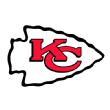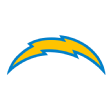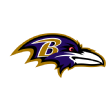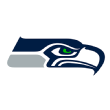There are no perfect NFL teams this season. Heading into Week 14, no team ranked in the top eight in both offensive and defensive DVOA. Each has a weakness, owing to an undeveloped part of its roster, the aftereffects of an injury stack, a schematic choice, or some combination of the three.
The right — or wrong — matchups produce unexpected results. The Rams have looked like an offensive juggernaut for most of the season, but matched up against a stifling Bears defense in the chill of Chicago, they collapsed on Sunday night. The Patriots have an inexplicable issue with winning in Miami. The Ravens look inferior to the Chiefs on paper, but they battled Kansas City to a draw on the road before fading in overtime.
As we get closer to the postseason, it’s a good time for our annual look at a weakness for each likely playoff team and which possible opponent might be most capable of exploiting it, their would-be kryptonite. In some cases, it’s an opponent the team already has beaten, but one game doesn’t offer as much predictive value as how a team has performed over the entire season. And in some cases, I’d still pick the team whose weakness was going up against the kryptonite team. But in general, all things being equal, there are opponents each team might want to avoid.
I’ve gone through and found a would-be spoiler for each of the 12 teams that currently hold playoff spots. I’ll start in the AFC, where the Chiefs might have already come face to face with their worst nightmare and narrowly lived to tell the tale.
(Note: Each team’s playoff chances are according to ESPN’s Football Power Index.)
Jump to a team:
AFC: KC | NE | HOU | PIT | LAC | BAL
NFC: NO | LAR | CHI | DAL | SEA | MIN
AFC

1. Kansas City Chiefs (100 percent chance of making playoffs)
Kryptonite: great running teams
Part of being a great football team is minimizing weaknesses. The Chiefs minimize their biggest weakness by rendering it irrelevant most weeks. Kansas City ranked 32nd in rush defense by DVOA heading into Sunday’s game with the Ravens. Most weeks, the Chiefs get out to a huge lead and make running the football a waste of time for the opposing team, which needs to throw the ball to catch up and keep pace with Patrick Mahomes & Co.
On Sunday, the Ravens’ defense did enough to slow down the Chiefs, although Mahomes did finish with 377 passing yards in K.C.’s 27-24 overtime win. Keeping the game close allowed Lamar Jackson and a vibrant Ravens rushing attack to pick at the Chiefs, with Baltimore running the ball for 198 yards and a touchdown. Sixty-three of Jackson’s 147 passing yards also came on play-action, including both of his passing scores.
The one X factor for the Chiefs against the run, of course, is Eric Berry. The star safety nearly made it back for this week’s game and might be back for Thursday’s critical tilt with the Chargers, which could essentially clinch the top seed in the AFC for Kansas City. A healthy Berry would be a massive upgrade at its weakest spot and give the Chiefs a plus run defender for their playoff run. Of course, it remains to be seen what Berry will look like once he gets back on the field.
Matchup to avoid: Baltimore Ravens
I understand that the Chiefs just beat the Ravens, but Baltimore put a real shock into the Chiefs at home, where Kansas City was 5-0 and outscoring teams by more than 16 points per game. It also came in a game in which the Chiefs recovered both of the game’s fumbles, including one (by Jackson) that came amid a potential game-winning drive for the Ravens. The Baltimore defense beat up Mahomes, knocking him down a staggering 15 times. Jackson and the Baltimore offense ran at will against the Chiefs, and the Heisman Trophy-winning quarterback is improving as an NFL passer. There are easier matchups out there for the Chiefs, even if they would come against tougher teams on paper.

Kryptonite: teams that slow down tight ends
There are not a lot of good ways to attack the Patriots, but we know from history that their offense tends to slow down with Rob Gronkowski unavailable. In 2018, Tom Brady has posted a 77.1 Total QBR with his star tight end on the field and a 48.3 QBR with Gronk sidelined. The effect isn’t quite as big over a five-year span, but go back through 2014 and there’s a noticeable difference over a large sample: Brady has a 77.5 QBR with Gronkowski in the huddle and a 60.3 QBR without him.
Furthermore, Brady’s four losses this season have come against teams who generally manage to funnel production away from tight ends. The Dolphins, Jaguars, Lions and Titans all allow fewer receiving yards per game to tight ends than the league average. Gronkowski also struggled to make his usual impact against the Jaguars (two catches for 15 yards) and Lions (four catches for 51 yards) while he was injured and missed the blowout loss against Tennessee.
Gronkowski was great until the last play of the game on Sunday in Miami, catching all eight of the passes thrown to him for 107 yards and a touchdown. You know what happened next: Gronk was sent out onto the field as a deep safety for what the Patriots thought was a Hail Mary situation, only for the Dolphins to throw a checkdown, hit on two laterals, and spring Kenyan Drake past a hobbled Gronkowski for a game-winning touchdown on what must go down as the play of the year.
As an aside, I would hesitate to blame Gronk for the loss, given that he was great on offense and placed into an unfamiliar situation in which he was not physically capable of doing his job. The Patriots also played sloppy football and put themselves at risk of falling prey to the Dolphins’ miracle play. Stephen Gostkowski missed an extra point and a field goal, Brady took a sack at the end of the first half when he incorrectly thought the Patriots had a timeout left, costing the Pats a chance at a field goal, and the Patriots failed to capitalize on a first-and-goal opportunity with 1:50 left and kicked a field goal to go up five instead of scoring the touchdown that would have sealed the game. The missteps aren’t going to matter, and when you’re up five with seven seconds left, you’re going to win 499 times in 500. The Dolphins pulled out a miracle, but the Patriots shouldn’t have left themselves exposed to one incredible play.
Matchup to avoid: Los Angeles Chargers
Brady has won his past seven games against the Chargers, but L.A. is going to be a scary matchup in the playoffs. The Chargers are allowing a passer rating of just 61.3 on throws to tight ends this season, the second-best rate in the league, and are third in QBR allowed on throws to tight ends. The 49ers’ George Kittle had an 82-yard touchdown against the Chargers in September, but he racked up 42 yards over the rest of the game. No other tight end has topped 55 yards in a game against Los Angeles so far, a list which includes a 6-yard game against the Chiefs’ Travis Kelce in the opener.
Kelce will get another shot against his division rivals Thursday, and we’ll have to monitor whether the Chargers struggle against the likely first-team All-Pro tight end without inside linebacker Denzel Perryman, who went down for the season in Week 10. If the Chargers can slow or shut down Kelce, they might very well be able to do the same to Brady and Gronk.

Kryptonite: running the ball
While the Texans have sprung Lamar Miller for a 58-yard run and a 97-yard run, Bill O’Brien’s offense just hasn’t been effective on the ground. Houston is 24th in the league in win expectancy added by its running game, the worst mark in the league for a team with a winning record. Just 20.1 percent of its runs have turned into first downs, the fourth-worst rate in the league.
Miller & Co. scored two of their three touchdowns against the Colts on Sunday on the ground, but Houston’s 25 carries produced just 89 yards and four other first downs. The Texans’ red zone performance has generally been an issue; Houston ranks 22nd in red zone efficiency and 25th in goal-to-go efficiency this season. Settling for field goals wasn’t an issue when the Texans were playing against the Jaguars, Titans and Bills, but things will be tougher for Houston come January.
Matchup to avoid: Kansas City Chiefs
The Chiefs are going to come up a few times in this piece. Here, the problem is built around how they break down on defense. Heading into Week 14, Bob Sutton’s defense ranked 13th in pass defense DVOA but dead last in rush defense DVOA. The easier competition might help the Texans run the ball more effectively, but the Texans would probably prefer to go after a defense that struggles against the pass with DeAndre Hopkins and Demaryius Thomas.
If you’re looking toward the NFC, while the Texans would be thrilled to make it to the Super Bowl, they would probably rather not see the Rams in Atlanta. Before Sunday night’s loss to the Bears, the Rams ranked eighth against the pass and a middling 25th against the run. Chicago promptly averaged more yards per run (5.5) than pass (3.7) during its 15-6 victory. Running at Aaron Donald is one way to try to take the Defensive Player of the Year candidate out of the game, but that might be out of the Texans’ capabilities.

Kryptonite: great tight ends
Even before the Steelers lost Ryan Shazier last season, Pittsburgh had issues dealing with opposing tight ends. Since Shazier has gone down with his career-threatening spinal injury, though, things have gotten worse. Pittsburgh has tried to get by with stretching players such as Jon Bostic and Morgan Burnett into linebacker spots in certain situations, but there’s just no replacing a potential an All-Pro like Shazier.
Before Sunday’s game, the Steelers had the fifth-worst DVOA against tight ends this season. Among playoff favorites, only the Texans had been worse against tight ends. And after Jared Cook caught seven passes on 10 targets for 116 yards in the loss in Oakland, the Steelers are now allowing a passer rating of 117.2 on throws to tight ends this year, the fourth-worst mark in the league.
Matchup to avoid: Kansas City Chiefs, New England Patriots
Pick one. In Week 2, Travis Kelce dominated the Steelers, catching seven passes on 10 targets for 109 yards and two scores. With no single player capable of covering Kelce, the Steelers went with zone looks and were burned by Patrick Mahomes‘ velocity. Pittsburgh didn’t really bother to cover Kelce on his 19-yard score up the seam in the first quarter or his 25-yard touchdown up the other seam in the third.
Kelce is the scariest tight end in football these days, but let’s throw an honorable mention in for Rob Gronkowski, who has absolutely owned the Steelers going back since before Shazier entered the league. His game-by-game numbers:
Over that six-game stretch, Gronk has racked up 39 catches for 664 yards and eight touchdowns. Prorate that over a full season and Gronkowski would post a 104-1,771-21 line. Even if you think Gronk has lost a step or two, the Steelers will not want to see the future Hall of Famer lining up across from them in January.

Kryptonite: deep passes
The Chargers have an aggressive, deep secondary, led by Pro Bowl cornerback Casey Hayward and Defensive Rookie of the Year candidate Derwin James. Since Gus Bradley arrived at the beginning of the 2017 season, the Chargers have intercepted 3.2 percent of opposing passes, the second-highest rate in football. In 2018, they rank sixth in Total QBR allowed (54.0) and eighth in passer rating allowed (87.4). With Joey Bosa back in the fold, the Chargers are a pass defense no team wants to face.
They have one very notable weakness, however. Heading into Week 14, the Chargers led the league in pass defense DVOA on short passes, which the NFL defines as passes traveling no more than 15 yards past the line of scrimmage in the air. Against deep passes — throws traveling 16 or more yards in the air — the Chargers ranked 32nd. Dead last. On Sunday, the Bengals had inexperienced passer Jeff Driskel go deep only three times, but the 25-year-old completed two of those three throws for 43 yards.
Matchup to avoid: Kansas City Chiefs
This is the last time I’ll throw the Chiefs out there, but they fit yet again here. This one shouldn’t surprise you, given that Mahomes has completed 51 deep passes this year, more than any other quarterback in the league. He also has attempted a league-high 107 deep throws, but he has been efficient: Mahomes has posted a 96.7 Total QBR on those passes, the fourth-highest mark in football. The three quarterbacks ahead of him include two passers the Chargers might worry about on the NFC side of the bracket in Russell Wilson and Drew Brees, as well as one they’re sure to avoid: Philip Rivers, who has a league-high QBR of 99.6 on deep throws this season.

Kryptonite: great run defenses
Since Lamar Jackson took over as the starter, the Ravens have become the most run-heavy team in the league. During Jackson’s four starts, John Harbaugh’s offense has run the ball a staggering 63.7 percent of the time. To put that in context, only four other teams have run the ball more than half of the time, and none of them has topped a run rate of 55 percent. The Ravens haven’t had any early blowouts in which they were afforded the luxury of milking the clock, either; running has been their game plan.
Over that four-week span, the Ravens have run for 914 yards, nearly topping what the Cardinals have accumulated all season (1,032). They have 50 first downs via the run, more than the Vikings have racked up over the entire campaign (44). As I mentioned in the Chiefs section, facing a run defense that ranked 32nd in DVOA coming into the week, Jackson & Co. ran the ball 39 times for 198 yards, 10 first downs, and a touchdown on Sunday.
The Chiefs aren’t the only weak run defense Jackson has gone up against; his first four starts have all come against run defenses that ranked in the bottom five by rush defense DVOA heading into Week 14, including the Bengals (28th), Falcons (29th) and Raiders (31st). Back in November, I argued that the Ravens should have benched Joe Flacco for Jackson before their Week 9 bye because they were about to face a friendly slate of defenses. Harbaugh publicly declined to do so, only for Flacco’s hip injury to force his hand. Now, it’s difficult to imagine the Ravens going back to Flacco if Jackson stays healthy.
Matchup to avoid: Houston Texans
Naturally, if the Ravens want to make a deep playoff run, they’re going to want to avoid tough run defenses. The most difficult run defense they’re likely to encounter in the postseason belongs to the Texans, who ranked second in DVOA heading into the week and held the Colts to 50 yards on 23 carries in Sunday’s 24-21 loss. Quarterbacks have had some success — Josh Allen, Dak Prescott and others have run 47 times for 220 yards against the Texans — but Romeo Crennel’s defense is allowing opposing running backs to run for just 3.3 yards per carry. Only the Saints have been more stifling.
NFC

Kryptonite: deep passes
The 11-2 Saints don’t have many weaknesses, and their losses come out of different books. New Orleans lost in Week 1 when Ryan Fitzpatrick and the Buccaneers dropped the hammer in a 48-40 shootout, and then rolled off 10 straight victories before the Cowboys manhandled them in a 13-10 Thursday night special. There are few common threads between those two defeats.
One place the Saints have been vulnerable all season, though, is on deep throws. When quarterbacks throw the ball 16 or more yards in the air, the Saints are allowing the league’s seventh-worst QBR at 94.7. Marshon Lattimore & Co. have seven interceptions on 92 such attempts this season, but even with those picks, opposing quarterbacks are averaging 14.3 yards per attempt on those passes.
In addition, there are six defensive pass interference penalties on those deep throws, adding 125 yards of penalties to those totals. The Saints have committed a league-high 14 pass interference penalties, and while three of them belonged to deposed corner Ken Crawley, replacement Eli Apple has three of his own since coming over from the Giants via trade. Smart teams will take shots at the Saints downfield.
Matchup to avoid: Los Angeles Rams
The Saints already beat the Rams earlier this season, but if you’re looking at the opponents they’re likely to face in the NFC playoffs, Sean McVay’s team would be the one I’d want to avoid if I were a Saints fan. With multiple weapons at wide receiver, the Rams are going to have a possible mismatch against Apple on every down. Jared Goff has completed 46 deep passes so far this season, the second-highest total in the NFL behind Patrick Mahomes.
When these two teams played the first time, Goff was 5-of-10 on those throws for 150 yards; one of them was picked off by the Saints’ Alex Anzalone, which helped break open the game just before halftime. There are few teams that have the ability to control the clock with their running game and go shot-for-shot downfield with the Saints. The Rams are the only one of those possible opponents in the NFC bracket.

Kryptonite: pressure on Jared Goff
Remember the incredible game Goff had against the Vikings on national television in Week 4? Since then, Goff has been far closer to average than great. Over the ensuing eight games, Goff ranks 20th in passer rating (90.4) and 18th in Total QBR (58.6), ranking just below San Francisco’s Nick Mullens in both categories. He has thrown nine interceptions, including four against the Bears in a shockingly awful performance on Sunday night, even given the presence of the league’s best pass defense on the other side of the field. In fact, let’s just cut to the chase …
Matchup to avoid: Chicago Bears
You saw what happened, right? The Rams would probably get to play the playoff rematch between these two teams in Los Angeles, which would alleviate concerns about the weather impacting Goff, but I think the bigger issue is with Goff struggling against pressure. In 2018, Goff has posted an 83.8 Total QBR when he’s unpressured, the fifth-best mark in the league. When he is pressured, though, Goff’s QBR falls all the way down to 11.3, which is just between Marcus Mariota and Josh Rosen for 25th in the league. That 72.5-point slide is the biggest drop-off for any quarterback in the NFL. Goff doesn’t want to see Khalil Mack again anytime soon.

Kryptonite: deep passes
Of course, the guy on the other side didn’t have a great night, either. While Goff posted the second-worst QBR of the week, opposing number Mitchell Trubisky won despite the week’s third-worst QBR. Trubisky went 16-of-30 for 110 yards with three interceptions, although he did run for 23 yards and throw a touchdown pass to reserve lineman Bradley Sowell on what was likely the heaviest offensive personnel in league history, with Trubisky joined by six offensive linemen and four defensive linemen.
The Bears will hope that Trubisky had a bad day at the office in his return from a shoulder injury, but even before the former second overall pick went down, deep throws had been an issue. On passes traveling 16 or more yards in the air this season, Trubisky ranks 26th in passer rating (68.4) and 27th in Total QBR (56.6), with more interceptions (seven) than touchdowns (six). Two of those interceptions came Sunday night.
Matchup to avoid: Minnesota Vikings
The Bears beat the Vikings 25-20 earlier this year, of course, but it came in a game in which Trubisky threw for just 165 yards on 31 attempts and was picked off twice. A pick-six from Eddie Jackson ended up as the margin of victory, as the Bears’ run defense held Dalvin Cook and Latavius Murray to 17 yards on 13 carries.
The Vikings will get a rematch in Minnesota in Week 17, and while the Bears will have likely clinched the NFC North by then, they represent an obstacle for Trubisky. The Vikings allow opposing quarterbacks a Total QBR of just 58.1 on passes within 15 yards of the line of scrimmage, the second-lowest rate in the league. On deeper throws, their QBR allowed rises to 88.5, which is 19th in the NFL. Trubisky wasn’t able to take advantage of the Rams on Sunday night despite the fact that the Rams were allowing a league-worst QBR of 98.7 on deep throws coming into the game. Will he be able to make plays downfield in January?

Kryptonite: dependence on Amari Cooper
I don’t know if you’ve noticed, but the Cooper trade has gone pretty well for the Cowboys. The Cowboys have gone 5-1 and claimed first place in the NFC East since dealing a first-round pick for the wide receiver. Over those six weeks, Cooper has racked up 40 catches for a league-high 642 receiving yards and six touchdowns. Dak Prescott struggled for most of Sunday’s win over the Eagles before getting on the same page with Cooper, and his numbers are significantly better with Cooper on the field; Prescott is averaging 8.1 yards per pass with a passer rating of 105.1 with Cooper in the huddle, up from 7.0 yards per pass and an 89.3 rating with Cooper on the sideline or with the Raiders.
When the trade happened, I suggested I understood the Cowboys’ logic in making the deal and felt like I was an outlier in terms of viewing this trade positively, but I still couldn’t have pictured this happening. Cooper has totally turned around this offense. He’s probably getting a little more credit than any receiver deserves — Washington has folded amid injuries, and the Dallas defense has taken a leap forward in recent weeks — but Cooper has been arguably the most important player in pushing the Cowboys to a division title.
Matchup to avoid: Chicago Bears
The matchup the Cowboys don’t want, then, is one in which the opposing team is capable of taking away the best wide receiver. The Bears have been excellent at just about everything on defense this season, with Kyle Fuller and the secondary posting the league’s second-best DVOA against No. 1 receivers heading into Week 14. Whether you define the Rams’ No. 1 wideout as Robert Woods or Brandin Cooks, those numbers aren’t going to decline much after Sunday night. With the Bears shutting down Cooper, Ezekiel Elliott would need to thrive for the Cowboys to move the ball on offense in a possible NFC Championship Game between these two tough defenses.

Kryptonite: passes to the left side of the field
The Seahawks’ secondary is one of the quiet success stories of the season. They shed the entirety of the Legion of Boom by the end of September, with Richard Sherman in San Francisco, Kam Chancellor forced into retirement, and Earl Thomas out for the year after breaking his leg. Seattle is starting modest free-agent addition Bradley McDougald and second-year safety Tedric Thompson at safety and running up second-year corner Shaquill Griffin and rookie fifth-round pick Tre Flowers at corner.
On paper, this should be one of the worst secondaries in the league. Pete Carroll has a certain magic in working with secondaries, though; remember that once upon a time, while Thomas was a first-round pick, Sherman and Chancellor were fifth-rounders and Byron Maxwell was a sixth-rounder. Carroll is a wizard with developing young defensive backs, and indeed, the young defensive backs surrounding the 28-year-old McDougald have developed nicely.
If there is a weak spot, though, it’s on the right side of the defense, where Flowers generally lines up. When you split the Seahawks’ pass defense into sections, the Seahawks ranked second in the league in DVOA on throws between the hashes and a respectable 11th on passes to the right side of the field, heading into Week 14. On throws to the left side, though, Flowers and the Seahawks rank 29th.
Matchup to avoid: New England Patriots
As always, teams can never be upset about the idea of possibly playing in a Super Bowl, but even ignoring what happened the last time these two teams played in a championship game, Carroll probably doesn’t want to see his old employers in Atlanta. Tom Brady throws 49.1 percent of his passes to the left side of the field, the highest rate in the league this season. He also has no qualms about picking apart the weakest link in a team’s secondary. The most frequent passer to the left among the five other likely NFC playoff teams is Prescott, whose 43.5 percent rate ranks ninth among regular starters.

Kryptonite: field goal kicking
Nothing new, but even after adding Dan Bailey, field goals have been an adventure for the Vikings. Bailey and Daniel Carlson have combined to go just 17-of-26 on field goals, good for a 1980s-esque conversion rate of 65.4 percent. By advanced metrics, the Vikings have cost themselves 1.4 wins on field goal kicking, per ESPN’s win probability added, which would be the third-worst mark for any team in a full season over the past decade behind the 2009 Ravens (minus-1.5 wins) and the 2018 Chargers (minus-1.8 wins).
1:13
Darren Woodson and Tedy Bruschi agree that the Vikings will have their hands full with the Seahawks in Week 14 on Monday Night Football.
Matchup to avoid: Chicago Bears
Bailey was 2-for-2 the first time these two teams played, but with the Vikings far more likely to finish as runners-up in the NFC North and face the Bears in Chicago come the postseason, would you want to rely on anybody in a purple uniform to kick field goals in Soldier Field in January weather? I didn’t think so. The rest of the NFC playoff picture should feature generally friendly conditions, given that the Cowboys and Saints play in domes and the Rams play in Los Angeles. If the Vikings end up against the Seahawks, well, it won’t be as cold — or as painful — as it was last time.
